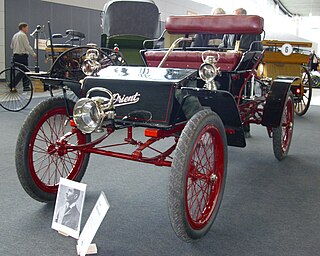
McLaughlin Motor Car Company Limited was a Canadian manufacturer of automobiles headquartered in Oshawa, Ontario. Founded by Robert McLaughlin, it once was the largest carriage manufacturing factory in the British Empire.

The Overland Automobile Company was an American automobile manufacturer in Toledo, Ohio. It was the founding company of Willys-Overland and one of the earliest mass producers of automobiles.

The Winton Motor Carriage Company was a pioneer United States automobile manufacturer based in Cleveland, Ohio. Winton was one of the first American companies to sell a motor car. In 1912, Winton became one of the first American manufacturers of diesel engines.

The Knox Automobile Company was a manufacturer of automobiles in Springfield, Massachusetts, United States, between 1900 and 1914. Knox also built trucks and farm tractors until 1924. They are notable for building the very first modern fire engine in 1905, and the first American vehicle with hydraulic brakes, in 1915.

Waltham Manufacturing Company (WMC) was a manufacturer of bicycles, motorcycles, motorized tricycles and quadricycles, buckboards, and automobiles in Waltham, Massachusetts. It sold products under the brand names Orient, Waltham, and Waltham-Orient. The company was founded in 1893, moving to self-propelled vehicles after 1898.

Stevens-Duryea was an American manufacturer of Veteran and Brass Era automobiles in Chicopee Falls, Massachusetts, between 1901 and 1915 and Vintage Cars from 1919 to 1927.

A high wheeler is a car which uses large diameter wheels that are similar to those used by horse-drawn vehicles. These cars were produced until about 1915, predominantly in the United States.

The Marion was an automobile produced by the Marion Motor Car Company in Indianapolis, Indiana from 1904 to 1915.

The Skene was an American automobile manufactured from 1900 to 1901. A twin-cylinder 5-hp steam car, it was built in Lewiston, Maine.

The LuLu cyclecar was produced by the Kearns Motor Truck Company in Beavertown, Snyder County, Pennsylvania from 1914 to 1915.

Single Center Spring Buggy Company was an American carriage and automobile manufacturer based in Evansville, Indiana. The Single Center factory manufactured the Zentmobile, Zent, Windsor, Worth, Single Center, Evansville, Simplicity and Traveler automobiles from 1903 to 1910.

The Staver and Staver-Chicago was an American Brass Era automobile manufactured at 76th and Wallace Streets in Chicago, Illinois, by the Staver Carriage Company from 1906 until 1914.

The Michigan was a brass era automobile manufactured in Kalamazoo, Michigan from 1904 to 1913 by the Michigan Buggy Company and its subsidiary the Michigan Motor Car Company.

Schacht was an American marque of automobiles and High-wheelers from 1904 to 1913, in Cincinnati, Ohio. The Schacht Manufacturing Company, later renamed Schacht Motor Car Company produced over 9,000 automobiles. The company was reorganized as the G.A. Schacht Motor Truck Company in 1914 and production of trucks and fire trucks continued until 1938.
The Success Automobile Manufacturing Company was a brass era United States automobile manufacturer, located at 532 De Ballviere Avenue, St. Louis, Missouri, in 1906.

The Metz Company was a pioneer brass era automobile maker established by Charles Herman Metz in Waltham, Massachusetts, from 1909 to 1922.

The Partin Manufacturing Company was a brass era American automobile manufacturer, headquartered at 29 South LaSalle Street, Chicago, Illinois from 1913 to 1917. The Partin-Palmer automobile and Pioneer cyclecar were produced.

Hatfield Motor Vehicle Company was a pioneer brass era American automobile company, built in Miamisburg, Ohio, in 1907 and 1908.
The George W. Davis Motor Car Company made Davis brand automobiles in Richmond, Indiana, from 1908 to 1929.



























